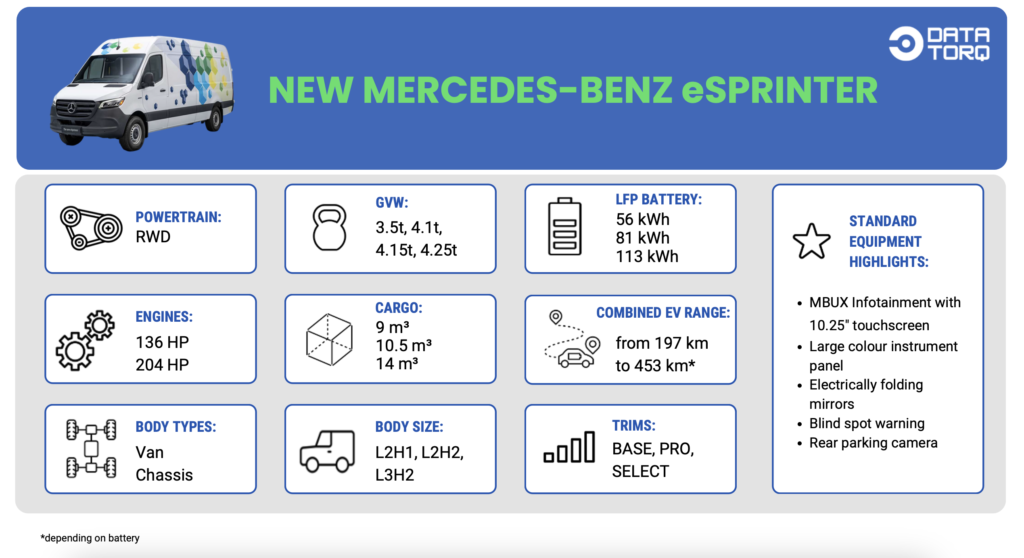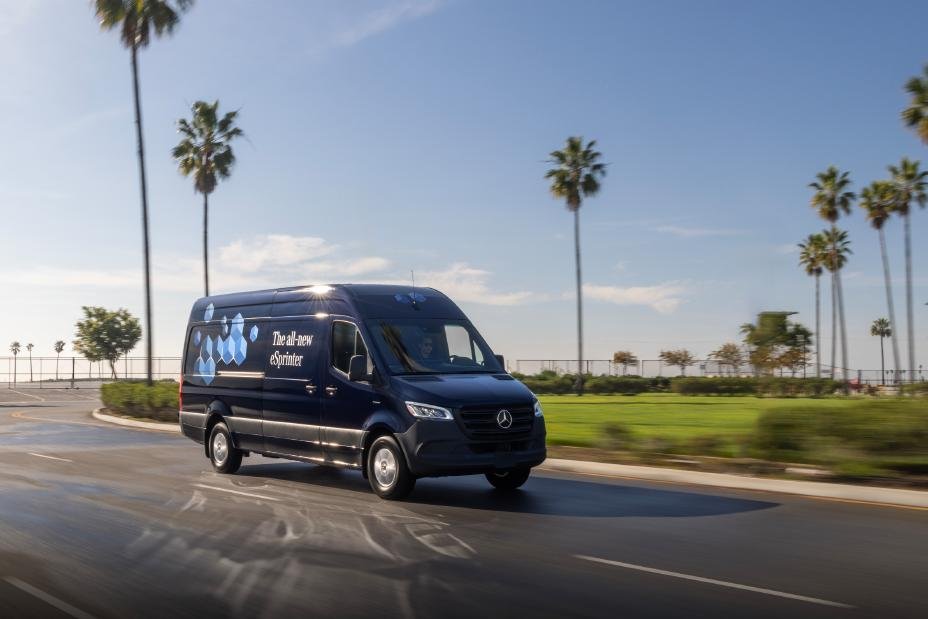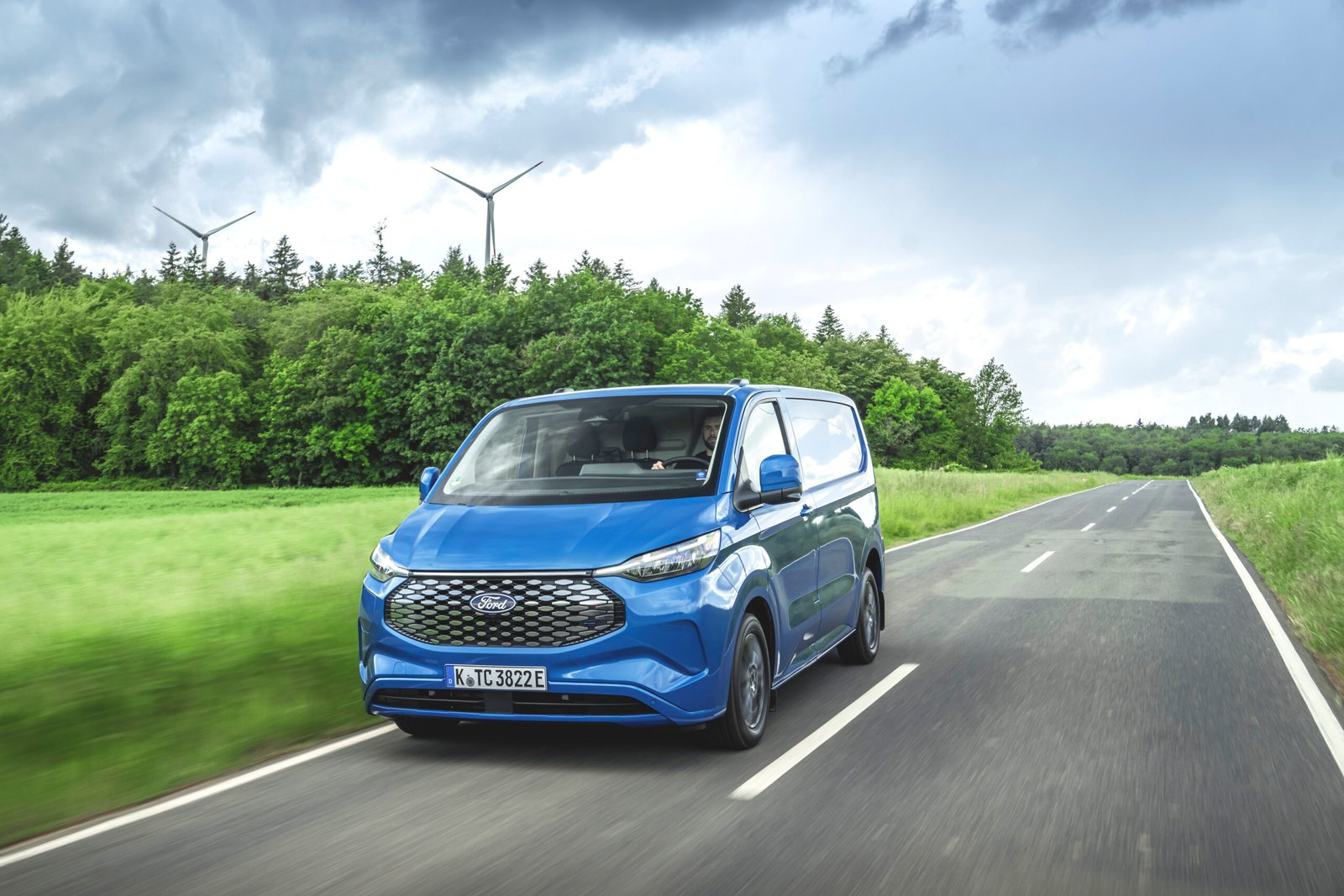The new Mercedes-Benz eSprinter, a fresh contender in the large electric van market, rolled off production lines on both sides of the Atlantic at the beginning of this year. This fully electric iteration of the popular Sprinter van promises a sustainable solution for businesses, featuring the same versatile capabilities, load capacity, and advanced technologies as its diesel-powered sibling.
However, as with any new vehicle, the eSprinter presents a unique mix of strengths and weaknesses. To help you decide if it’s the right choice for your fleet, let’s analyse its key features and potential drawbacks.

What’s New
- Lithium-Iron Phosphate (LFP) Battery Options:
- Available in three capacities: 56 kWh, 81 kWh, and 113 kWh.
- Largest Variety on the Market: Most competitors offer only one Lithium-Ion battery option. For instance, the eTransit has a 68 kWh battery, while Stellantis models are equipped with a 110 kWh battery. Maxus eDeliver9 also offers three battery capacities, while the new Master E-Tech comes in 2 choices, but none has the option of the large, over 100 kWh capacity (52 kWh, 72 kWh and 88 kWh for the former, 40 kWh and 87 kWh for the latter)
- Environmentally Friendly: LFP batteries are more eco-friendly, with a lower manufacturing footprint and longer lifespans than traditional lithium-ion batteries. They can support up to four times more charging cycles in their lifespan.
- Enhanced Charging Technology: The eSprinter can now be charged using both alternating current (11 kW AC) and direct current (50 kW DC), which are faster than the pre-facelift model’s capabilities of 7.4kW (AC) and 20kW (DC).
- New, More Powerful Engines: equipped with 100 kW (136 HP) or 150 kW (204 HP) engines. In comparison, competitors like Ford and Stellantis offer more powerful 270 HP engines in their electric heavy van models.
- Three Trim Levels: BASE, PRO and SELECT. Specifications are largely uniform across European countries where it is sold.
| Specs | Base** | Pro | Select |
|---|---|---|---|
| Passenger Airbag* | ✅ | ✅ | ✅ |
| GSR2 Safety Features | ✅ | ✅ | ✅ |
| Plastic floor lining in the cargo area* | ✅ | ✅ | ✅ |
| LED lights in the cargo area* | ✅ | ✅ | ✅ |
| Tempomat (Cruise control)* | ✅ | ✅ | ✅ |
| Mbux system with 10.25* touch screen | ✅ | ✅ | ✅ |
| Colour instrument panel | ✅ | ✅ | ✅ |
| Tempmatic A/C | ✅ | ✅ | |
| 5V USB | ✅ | ✅ | |
| Height & depth adjustable steering wheel | ✅ | ✅ | |
| LED headlights | ✅ | ||
| High beam assistant | ✅ | ||
| Charging package | ✅ | ||
| Leather steering wheel | ✅ |
*New equipment vs. old model
**Note: Base trim is not available in France, the UK, Spain, the Netherlands and Poland
- Enhanced Safety Features: Mercedes, like many other manufacturers, used the model’s facelift to add safety features required by GSR2 regulation:
- Active Brake Assist
- Active Lane Keeping Assist
- Blind Spot Assist (includes Rear Cross Traffic Alert)
- Intelligent Speed Assistant
- Rear Camera
- Driver Attention Assist
- Tire Pressure Monitoring System
- Rear-Wheel Drive (RWD) — Unlike the previous Forward-Wheel Drive (FWD) model, the new RWD eSprinter offers better weight distribution and stability of this large van. This is also aided by Mercedes-Benz’s modular drivetrain approach, which places the electronics at the front, the motor at the rear, and the battery in between. Ford’s eTransit is the only other electric heavy van offering rear-wheel drive versions.
- Gross Vehicle Weight (GVW): ranges from 3.5t to 4.25t, with two intermediate options of 4.1t and 4.15t.
Strong points
- Low Centre of Gravity: provides better initial traction on slippery surfaces and the built quality minimises road noise, a crucial aspect for electric vehicles.
- Driving and Recuperation Modes: Offers three driving modes (Maximum Range, Economic, and Comfort) and four manual recuperation modes (from D++ to D-), plus the efficient D Auto.
- Optional equipment: A wide array of optional equipment includes, but is not limited to, electrically powered sliding doors, bulkhead with sliding door or digital rear-view mirror.
- Electric range: The largest 113 kWh battery provides up to 440 km on a single charge (WLTP Combined Cycle), nearly triple the range of its predecessor. Stellantis’ electric heavy vans provide close autonomy ranges, though slightly under 400 km, while the new Master E-Tech promises a 460 km WLTP range with a smaller battery.
Weaknesses
- DC Charging capacity: standard 50kW DC charging capacity is lower than competitors. eTransit offers a fast-charging capability of 115 kW DC, recharging up to 80% in 34 minutes, while new Stellantis models like Fiat e-Ducato or Peugeot e-Boxer offer 150 kW DC fast charging. eSprinter’s 115 kW DC charging capability is optional.
- Limited Standard Equipment: compared to its competitors’ rich-equipped EV models, eSprinter doesn’t offer important features as standard:
- The eSprinter lacks a full digital cluster, a feature standard in new Stellantis vansThe MBUX infotainment lacks mobile app connectivity, a feature available in eTransit, eDeliver9, and Stellantis models
- BASE versions do not include an A/C system
Overall, the new eSprinter is a significant improvement from its pre-facelift version in terms of powertrain and battery capacity. It is a strong contender among the newly refreshed range of electric EVs, despite its few weaknesses.
Want an in-depth analysis of eSprinter’s equipment and price range in your market?
Get in touch today


